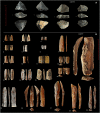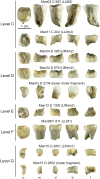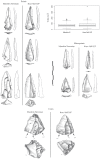Modern human incursion into Neanderthal territories 54,000 years ago at Mandrin, France
- PMID: 35138885
- PMCID: PMC8827661
- DOI: 10.1126/sciadv.abj9496
Modern human incursion into Neanderthal territories 54,000 years ago at Mandrin, France
Abstract
Determining the extent of overlap between modern humans and other hominins in Eurasia, such as Neanderthals and Denisovans, is fundamental to understanding the nature of their interactions and what led to the disappearance of archaic hominins. Apart from a possible sporadic pulse recorded in Greece during the Middle Pleistocene, the first settlements of modern humans in Europe have been constrained to ~45,000 to 43,000 years ago. Here, we report hominin fossils from Grotte Mandrin in France that reveal the earliest known presence of modern humans in Europe between 56,800 and 51,700 years ago. This early modern human incursion in the Rhône Valley is associated with technologies unknown in any industry of that age outside Africa or the Levant. Mandrin documents the first alternating occupation of Neanderthals and modern humans, with a modern human fossil and associated Neronian lithic industry found stratigraphically between layers containing Neanderthal remains associated with Mousterian industries.
Figures









Similar articles
-
The three waves: Rethinking the structure of the first Upper Paleolithic in Western Eurasia.PLoS One. 2023 May 3;18(5):e0277444. doi: 10.1371/journal.pone.0277444. eCollection 2023. PLoS One. 2023. PMID: 37134082 Free PMC article.
-
The dentition of a new adult Neanderthal individual from Grotte Mandrin, France.J Hum Evol. 2024 Nov;196:103599. doi: 10.1016/j.jhevol.2024.103599. Epub 2024 Oct 2. J Hum Evol. 2024. PMID: 39357284
-
Bow-and-arrow, technology of the first modern humans in Europe 54,000 years ago at Mandrin, France.Sci Adv. 2023 Feb 22;9(8):eadd4675. doi: 10.1126/sciadv.add4675. Epub 2023 Feb 22. Sci Adv. 2023. PMID: 36812314 Free PMC article.
-
Archaic human genomics.Am J Phys Anthropol. 2012;149 Suppl 55:24-39. doi: 10.1002/ajpa.22159. Epub 2012 Nov 2. Am J Phys Anthropol. 2012. PMID: 23124308 Review.
-
Archaic admixture in human history.Curr Opin Genet Dev. 2016 Dec;41:93-97. doi: 10.1016/j.gde.2016.07.002. Epub 2016 Sep 20. Curr Opin Genet Dev. 2016. PMID: 27662059 Review.
Cited by
-
Reconstructing contact and a potential interbreeding geographical zone between Neanderthals and anatomically modern humans.Sci Rep. 2024 Sep 3;14(1):20475. doi: 10.1038/s41598-024-70206-y. Sci Rep. 2024. PMID: 39227643 Free PMC article.
-
Europe's first humans hunted with bows and arrows.Nature. 2023 Feb 22. doi: 10.1038/d41586-023-00526-y. Online ahead of print. Nature. 2023. PMID: 36814024 No abstract available.
-
The three waves: Rethinking the structure of the first Upper Paleolithic in Western Eurasia.PLoS One. 2023 May 3;18(5):e0277444. doi: 10.1371/journal.pone.0277444. eCollection 2023. PLoS One. 2023. PMID: 37134082 Free PMC article.
-
Ochre-based compound adhesives at the Mousterian type-site document complex cognition and high investment.Sci Adv. 2024 Feb 23;10(8):eadl0822. doi: 10.1126/sciadv.adl0822. Epub 2024 Feb 21. Sci Adv. 2024. PMID: 38381827 Free PMC article.
-
Optimal linear estimation models predict 1400-2900 years of overlap between Homo sapiens and Neandertals prior to their disappearance from France and northern Spain.Sci Rep. 2022 Oct 13;12(1):15000. doi: 10.1038/s41598-022-19162-z. Sci Rep. 2022. PMID: 36229473 Free PMC article.
References
-
- Hublin J.-J., Ben-Ncer A., Bailey S. E., Freidline S. E., Neubauer S., Skinner M. M., Bergmann I., le Cabec A., Benazzi S., Harvati K., Gunz P., New fossils from Jebel Irhoud, Morocco and the pan-African origin of Homo sapiens. Nature 546, 289–292 (2017). - PubMed
-
- Scerri E. M. L., Thomas M. G., Manica A., Gunz P., Stock J. T., Stringer C., Grove M., Groucutt H. S., Timmermann A., Rightmire G. P., d’Errico F., Tryon C. A., Drake N. A., Brooks A. S., Dennell R. W., Durbin R., Henn B. M., Lee-Thorp J., deMenocal P., Petraglia M. D., Thompson J. C., Scally A., Chikhi L., Did our species evolve in subdivided populations across Africa, and why does it matter? Trends Ecol. Evol. 33, 582–594 (2018). - PMC - PubMed
-
- Harvati K., Röding C., Bosman A. M., Karakostis F. A., Grün R., Stringer C., Karkanas P., Thompson N. C., Koutoulidis V., Moulopoulos L. A., Gorgoulis V. G., Kouloukoussa M., Apidima Cave fossils provide earliest evidence of Homo sapiens in Eurasia. Nature 571, 500–504 (2019). - PubMed
-
- Hublin J.-J., The modern human colonization of western Eurasia: When and where? Quat. Sci. Rev. 118, 194–210 (2015).
LinkOut - more resources
Full Text Sources

